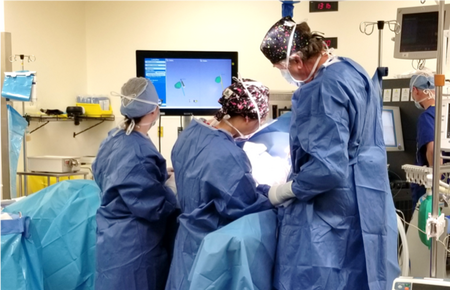Queen’s University researchers have gained recognition for the discoveries they have made in medicine, engineering, and the sciences; innovations that have improved the lives of people around the world. To make sure that the university and the public continue to benefit from this work, Queen’s Partnerships and Innovation (QPI) promotes the discoveries of university researchers who have assigned their intellectual property to Queen’s and whose work is ready for licensing and commercial application. QPI leads the commercialization processes, including the protection of the intellectual property, the creation of strategies to further its development, the search for funders, partners, and licensees, the negotiation of terms, the management of relationships, the collection of licensing and royalty revenues, and their disbursement to inventors.
“Everyone comments on how great the technology is, and how impressed they are with the work that’s been done.”
Queen’s Partnerships and Innovation’s (QPI) Jason Hendry is talking about Navi-Knife, an exciting surgical tool created at Queen’s University by Professors Gabor Fichtinger and Parvin Mousavi from the School of Computing and Doctor John Rudan, previously the Britton Smith Chair in Surgery at Queen’s School of Medicine and current holder of the Chair in Surgical Innovation.

On the far right is the iKnife mass spectrometry unit and operator. It is connected to the cautery device operated by the surgeon while the location of the lesion and the tools are illustrated in real-time on the overhead monitor (middle). Photo courtesy of Queen's Health Sciences.
Those reactions certainly sound promising. Navi-Knife was developed to answer a real-world problem.
“We were contacted by Dr. Jay Engel, Head of Oncological Surgery in the School of Medicine at Queen’s University, through a resident of his,” says Fichtinger. When it came to breast cancer surgery, “They were not satisfied with the standard of care.”
In what are known as lumpectomies, where the tumour is removed but the breast is left as intact as possible, it was customary, and safer, for surgeons to remove a margin of healthy tissue along with the tumour to make sure no cancer was left behind. A desirable goal, but it also meant that many patients might need reconstructive surgery after the fact.
Part of the reason for this is the information surgeons are given to work with. Before their operation, a patient will be sent to radiology, where their breast will be scanned using ultrasound and then a needle inserted into the breast to mark the location at the centre of the tumour. This requires, as Rudan puts it, “millions of dollars’ worth of equipment.”
The surgeons, however, do not get this information. What they get is a drawing based on that, what Fichtinger characterizes as “a sketchy treasure map.” Using this, they proceed to remove the tumour. As the location of the needle is seldom exact, however, there is always a danger that some portion of the tumour will be left behind.
What the Queen’s researchers have developed is a system that shows the surgeon the position and shape of the tumor relative to where they are operating with an electrocautery device. The scalpel in this case is a small probe that uses a current to burn through tissue. Attaching an electromagnetic sensor to a localization wire commonly used in lumpectomy surgery gives them the ability to track the centre of the tumour. Then, says Fichtinger, “Once you have that, it makes sense to have ultrasound in the operating room.”
The ultrasound generates a three-dimensional image of the tumour. The software they have developed allows the surgeon to see the 3D image of the tumor and the position of the cautery relative to it in real time. Their technology combines both in a way that will make lumpectomies less intrusive and perhaps, by reducing the need for reconstructive surgery, save the system money and patients any additional stress.
Over the past few years, Rudan, Fichtinger, and Mousavi have been collaborating with researchers at Imperial College in the United Kingdom to help them with their work on the iKnife, a futuristic surgical tool that captures the smoke from the tissue vapourized in the process of electrocautery, cleans it, and then passes it through a spectrometer. There is still work to be done, but ultimately this information will help determine whether the surgeon has cut through tumour or healthy tissue. Combining this with the navigation system developed by Fichtinger, and machine learning innovations by Mousavi, could have revolutionary consequences in dealing with tumours. Queen’s, Imperial, and Maastricht University are working together with Waters Corporation, the manufacturers of the iKnife technology, to develop new ways to use the knife by harnessing it to their navigation and AI technology. Preliminary trials show that the iKnife combined with the navigation software is not only effective at reducing the amount of healthy tissue removed, but also, thanks to the analysis carried out via machine learning of spectrometry data, is more effective at ensuring that no cancerous material is left behind.
QPI has been helping the three researchers in a number of ways, including the negotiation of several agreements between and among the collaborating institutions and Waters, and securing patents on the various unique components of their navigation system. QPI also helped them secure an Innovation to Industry grant from NSERC. While continuing their partnership with Waters, the three innovators are also working with QPI to find other partners that might be interested in commercializing the navigation technology.
Readers interested in licensing or learning more about the Navi-Knife technology, should contact Jason Hendry at jason.hendry@queensu.ca.
 About Vice-Principal Research
About Vice-Principal Research